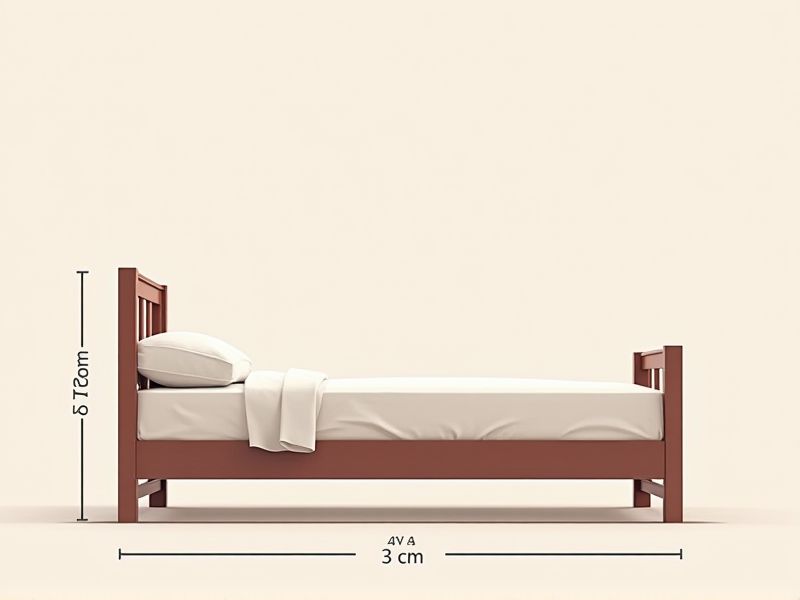
When designing or evaluating a single bedroom, it's important to consider standard dimensions to ensure functionality and comfort. Typically, a single bedroom should have a minimum floor area of around 9 to 10 square meters (approximately 97 to 108 square feet) to comfortably fit a single bed, a small wardrobe, and a desk or nightstand. For example, common dimensions range from 2.7 x 3.6 meters (9 x 12 feet) to 3 x 3 meters (10 x 10 feet). These measurements provide enough space for basic furniture while allowing for ease of movement, making the room practical and comfortable for its occupant.
Minimum Room Size
The minimum room size for a standard single bedroom typically ranges from 70 to 100 square feet, ensuring enough space for essential furniture such as a twin or full-sized bed, a desk, and storage units. To optimize comfort, the room should include at least one window for natural light and ventilation, with a minimum height of 8 feet to create an open atmosphere. Local building codes may also dictate specific requirements for ingress and egress, affecting your design choices. Understanding these minimum standards can help you plan an efficient and comfortable living space tailored to your needs.
Bed Size Compatibility
A standard single bedroom typically accommodates a twin bed, which measures 38 inches wide by 75 inches long. For those seeking more space, a twin XL bed offers an additional 5 inches in length, suitable for taller individuals. Room dimensions should ideally be around 10 feet by 10 feet to ensure comfortable movement and furniture placement. Ensure your bed frame and accessories, such as nightstands, fit within these space parameters to maintain an organized and functional layout.
Closet Space
A standard single bedroom typically features a closet space measuring around 5 to 6 linear feet, providing ample storage for clothing and personal items. The closet may come equipped with shelves, hanging rods, and sometimes drawers, optimizing organization and accessibility. In some modern designs, you might find built-in or walk-in closets that expand the available space, allowing for more extensive wardrobe collections. Prioritizing efficient closet organization can enhance the overall functionality and aesthetic of your bedroom.
Window Placement
In a standard single bedroom, optimal window placement significantly enhances natural light and ventilation, essential for creating a comfortable atmosphere. Ideally, windows should occupy 10-15% of the wall area, ensuring ample daylight without compromising privacy. Placing windows on the south or southeast walls maximizes sun exposure throughout the day, which can also improve energy efficiency. Your choice of window size and height can further influence the room's perception of space, making it feel larger and more inviting.
Door Clearance
The standard door clearance for a single bedroom should typically measure at least 32 inches wide to accommodate easy access for all users, including those with mobility aids. This measurement ensures that furniture can be moved in and out without obstruction, maximizing the usable space of the room. The door height should generally be around 80 inches to provide ample room for most individuals. When designing your single bedroom, consider these dimensions to enhance functionality and comfort.
Furniture Arrangement
In a standard single bedroom measuring approximately 100 to 150 square feet, efficient furniture arrangement is crucial for maximizing space. A twin bed, typically 39 inches wide, is often positioned against a wall to open up floor space, while a compact nightstand can complement it on one side. A small desk or dresser, ideally no wider than 30 inches, can be placed opposite the bed to ensure functional use of the area. Prioritizing multi-functional furniture, such as a bed with built-in storage, can significantly enhance usability and organization in your single bedroom.
Flooring Space
A standard single bedroom typically ranges from 90 to 150 square feet, providing enough space for essential furnishings like a bed, dresser, and a small desk. Flooring options like hardwood, laminate, or carpet significantly influence the room's ambiance; for instance, hardwood floors can give a modern touch, while carpet adds warmth underfoot. Adequate space planning is crucial; typically, you should aim for at least 2 to 3 feet of clearance around the bed for ease of movement. Properly designed, a single bedroom can maximize functionality without compromising comfort or style.
Ceiling Height
The standard ceiling height for a single bedroom typically ranges from 8 to 10 feet, providing ample space for air circulation and natural light. A higher ceiling, above 10 feet, can create an illusion of a larger area, enhancing the overall aesthetic and comfort. For optimal design, consider incorporating elements such as crown molding or ceiling fans, which can further elevate the room's ambiance. Ensuring sufficient ceiling height not only improves the room's feel but also supports efficient heating and cooling throughout the year.
Wall Outlets
In a standard single bedroom, having at least two wall outlets is essential for powering electronic devices such as lamps, chargers, and small appliances. It is recommended that these outlets are strategically placed near the bed and work area, facilitating easy access for your daily needs. A minimum height of 12 inches from the floor to the outlet is ideal to ensure safety and convenience. In some designs, adding USB wall outlets can enhance functionality, allowing for the simultaneous charging of multiple devices without the clutter of adaptors.
Heating And Cooling Access
In a standard single bedroom, maintaining optimal heating and cooling is essential for comfort, typically achieved through a dedicated HVAC system or a window unit with a BTU (British Thermal Unit) rating appropriate for the room size, usually around 5,000 BTUs for spaces up to 150 square feet. Insulation quality significantly influences energy efficiency, with R-values ranging from 13 to 30 recommended for walls and ceilings to minimize heat loss or gain. Strategically placed ceiling fans can enhance air circulation, improving perceived temperature while reducing reliance on mechanical systems. You can also improve indoor climate control by using programmable thermostats, which can reduce energy consumption by up to 10-15% compared to traditional thermostats.
